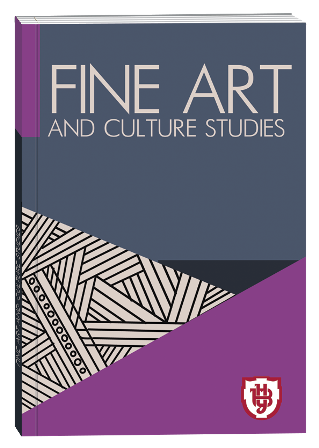"LIVING CRAFTS": TRADITIONAL DECORATIVE ART IN THE MUSEUM SPACE
DOI:
https://doi.org/10.32782/facs-2025-2-29Keywords:
intangible cultural heritage, traditional crafts, museum representation, cultural identity, decorative artsAbstract
Purpose of the study. This article analyzes the exhibition project “Living Crafts”, implemented by the National Museum of Decorative Art of Ukraine from March to June 2025, as a tool for the preservation and promotion of intangible cultural heritage. It explores the historical context of Ukrainian craft development from the late 19th to the early 21st century, the impact of social transformations on traditional forms of decorative art, and current challenges in their safeguarding.Special attention is given to the museum representation of 19 elements from the National Inventory of Intangible Cultural Heritage of Ukraine, including textiles, embroidery, ceramics, decorative painting, pysanka-making, and beadwork. The study emphasizes the role of the museum as a platform for intergenerational dialogue, cultural identification, and support of living traditions. Using an interdisciplinary approach, the exhibition's potential is examined in terms of shaping national identity, supporting artisans, engaging audiences, and creating sustainable models for the protection of intangible cultural heritage.Methodology. The study applies an interdisciplinary approach that combines elements of art history, ethnography, museum studies, and legal aspects of intangible cultural heritage protection. The main methods include literature analysis, comparative-analytical method, as well as interviews and surveys.Scientific novelty of the research. The scientific novelty of this research lies in the comprehensive analysis of exhibition activity as a tool for the preservation, promotion, and interpretation of intangible cultural heritage in Ukraine, based on the case of the “Living Crafts” exhibition. For the first time, a thorough examination has been conducted of the museum representation of elements from the National Inventory of ICH, in combination with the interpretive, educational, and institutional functions of the museum in a contemporary context.Key aspects of novelty:− Identification of the interconnection between exhibition practices and the formation of national identity in the context of globalization and cultural transformation; − Unveiling the potential of exhibitions as platforms for intergenerational dialogue and cultural renewal of traditions; − Analysis of the museum approach to the safeguarding of intangible heritage through inventorying, educational programs, and the inclusion of tradition bearers in the exhibition process; − Assessment of traditional crafts as a living knowledge system with not only aesthetic but also deep socio-cultural and symbolic significance.Conclusions. The presentation of intangible cultural heritage in the museum space plays a crucial role in preserving and transmitting the cultural code of a nation. Through the exhibition “Living Crafts”, the museum fulfills not only its research mission but also its educational and communicative functions. By applying an inclusive approach and highlighting regional crafts, the exhibition contributes to the formation of national identity, intergenerational dialogue, and the popularization of authentic traditions in the modern world.
References
Бабенко В. А. Коцарство в Харьковской губернии. Вестник Харьковского историко-филологического общества. 1913. № 4. С. 1–40. URL: https://www.calameo.com/read/004761641d6a8a7d30a44 (Дата звернення: 09.05.2025)
Гринюк М. М. Образний світ Валентини Джуранюк.Чернівці : Друк-АрТ, 2013. 72 с.
Жіноча сорочка Борщівсько-Заставнівського Придністров’я: альбом. / упоряд. Л. Булгакова-Ситник. Львів : Інститут колекціонерства українських мистецьких пам’яток при НТШ, 2013. 336 с.
Коман Г. М. Традиційне ткацтво осередку народних промислів Глиняни міжвоєнного періоду Галичини (минуле та сьогодення). Матеріали звітної наукової конференції викладачів, докторантів, аспірантів університету за 2022 рік. – Івано-Франківськ : Прикарпатський національний університет імені Василя Стефаника, 2023. С. 171–172. URL: materialy-zvitnoi-konferentsii-vykladachiv-2023-rik.pdf (Дата звернення: 09.05.2025)
Литовченко В., Дем’ян В. Нематеріальна культурна спадщина як найголовніший інструмент збереження української нації: монографія. Київ : Креативна агенція «Артіль», 2023. 180 с.
Манько В. Українська народна писанка. Львів : Свічадо, 2008. 81 с.
Міщанин В. Д. Північна група малих осередків гончарства Опішненського гончарного району (друга половина ХІХ – ХХ століття). Опішне : Українське народознавство, 2005. 298 с.
Петриківський розпис : книга-альбом /упоряд. О. І. Шестакова. Київ : Мистецтво, 2015. 240 с.
Стахів О., Матвійчук О., Зохнюк С. Обухівський рушник: навчальний посібник. Обухів : Об’єднання майстрів «Творча спадщина», 2024. 32 с.
Стельмащук Г. Г. Українські народні головні убори. Львів : Апріорі, 2013. 276 с.
Ліжники Василини Калинич. Каталог виставки. /упоряд. Я. Ткачук . Івано-Франківськ : Облполіграфвидав, 1989. 10 с.
Тихонова Л. О. Кролевецькі рушники в колекції Національного музею українського народного декоративного мистецтва. Кролевеччина від давнини до сьогодення : матеріали четвертої наук.-практ. конф. (20 вересня 2013 р.) / упоряд. В. С. Бобровський. Кролевець : Домінант, 2013. 72 с.
Тихонова Л. О. Решетилівські килими в колекції Національного музею українського народного декоративного мистецтва. Народні художні промисли України: історія, сьогодення, перспективи : науковий збірник за матеріалами Всеукраїнської науково-практичної конференції. С. 127-133
Федорчук О. Українські народні прикраси з бісеру: історія, типологія, художні особливості. Львів : Свічадо, 2023. 120 с.
Спадщина = MİRAS = The Heritage / упоряд. О. Савченко, Т. Савченко. Київ : Скарбниця Національного музею історії України, 2024. 224 с.







